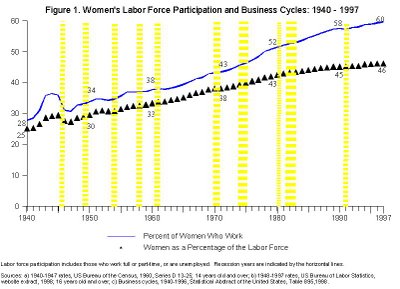Previous to this, Mollie tendered an excellent argument that the origins of women entering the labor force was due to Rosie the Rivetter, not the women's liberation movement. But it seems labor force participation dropped back to normal levels after the conclusion of WWII.

Regardless, Dave is now officially donned a junior deputy economist for the speed in which he got the chart!
ALL HAIL DAVE!
2 comments:
Hail to Dave for finding a chart. But don't get carried away with the data. Charts are only as good as the data which is input on them.
First of all, I must admit that I was giving history as far as I remembered it. (never was too good in history) After further research, I have to inform all the Rosie was not the first by any means.
Brief history lesson for women in the workplace in U.S.:
1. Women went to work taking over men's jobs (and the family farm) as early as the Revolutionary War.
2. Irish immigration - everyone worked to survive. Didn't matter if it was male or female. Both worked the crappiest of crappy jobs. **long live the Irish!**
3. 1840s, the women's rights movement - remember the Suffragetes?
4. WWI - men gone again. Time for women to save the economy again.
5. WWII - Rosie and gang.
6. Korean War, VietNam War - women to the rescue, but not as severe as WWI and WWII.
7. Yes, during the 50s and 60s more women returned home to stay with family. Why? One of the biggest reasons was the Bible Thumpers telling everyone that women belonged at home.
8. Finally, Women's Lib. Burn the bras baby, time to be liberated! Equal pay for all. No more discrimination based on gender.
Hi.... Actually, one very plausible theory is that women's increased workforce participation in the late 1950s helped to CAUSE the women's movement. As the blogger here has already noted, women's participation in the wage-earning workforce surged during WWII. When the war ended, the gov't asked women to get out of those jobs (and companies booted them out) and they did get out. BUT, by the end of the 1950s, women's workforce participation surged back up, only now, with men in the workforce and not off to war, women saw that their wages were lower than men's even when women had the same jobs as men. When Betty Friedan and Gloria Steinem, etc... called for greater women's rights in the mid-60s, many women in the U.S. were primed to support that cause because they wanted equal treatment in the workforce.
Post a Comment